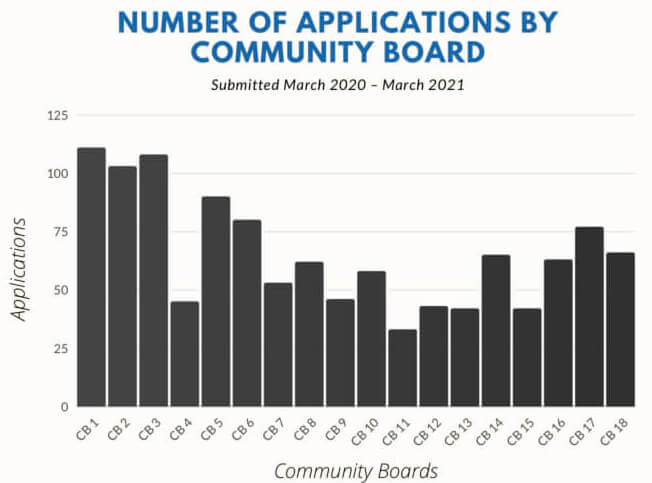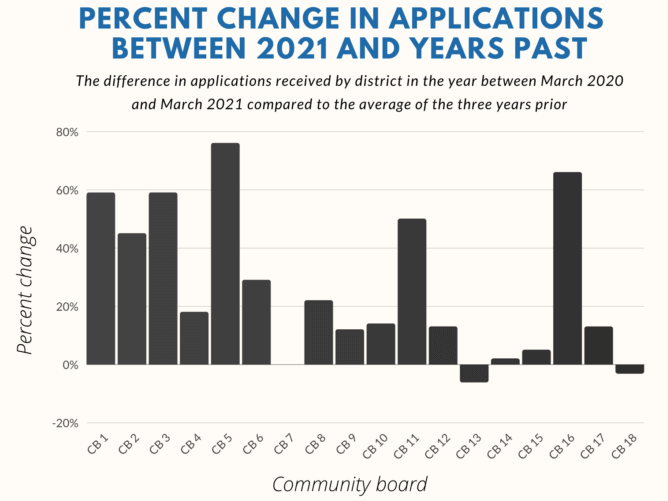Applications to Serve on Brooklyn's Community Boards Surge as Virtual Meetings Continue
More people applied to serve on Brooklyn’s community boards in 2021 than in any year since at least 2017, with some boards seeing up to a 58 percent jump in applications when compared to 2020.

A virtual meeting hosted by Brooklyn Community Board 6 in October. Screenshot via Brooklyn Paper
More people applied to serve on Brooklyn’s community boards in 2021 than in any year since at least 2017, with some boards seeing up to a 58 percent jump in applications when compared to 2020.
The borough’s 18 community boards — which issue recommendations on hyperlocal issues such as transportation, education and land use — received more than 1,200 applications for 2021, according to figures from Borough Hall. Community boards are comprised of up to 50 non-salaried members apiece — all of whom must live, work or have some stake in the community, such as a child enrolled in a local school.
This year’s numbers mark a significant increase over the 981 applications for 2020 and the 809 applications in 2019, according to the data.
The civic boards in northern Brooklyn generally received the most applications. Community Board 1 in Williamsburg and Greenpoint; Community Board 2, which includes Downtown Brooklyn, Brooklyn Heights and Clinton Hill; and Community Board 3 in Bed Stuy all saw more than 100 applicants between March 2020 and March 2021 — more than any Brooklyn board had received in at least three years.

One community board leader attributed the uptick to the fact that meetings have gone virtual because of the COVID-19 pandemic.
“It’s truly because of virtual [meetings]. Now they’re more engaged,” said Community Board 3 District Manager and City Council candidate Henry Butler. “Now people sitting at home have the opportunity to join community board meetings.”
Community Board 3 logged 108 applications between March 2020 and March 2021 — the second largest number in the borough behind Williamsburg and Greenpoint’s Community Board 1, which received 111. The board also had one of the largest increases in applicants year over year, with 57 percent more people applying in 2021 than in 2020.
The board’s popularity could be because of its particularly seamless transition to WebEx and its usage of social media, Butler said. Community Board 3 has more Facebook followers than any other board in the borough, and posts updates about upcoming meetings and events daily.
“We post the next meeting on our Facebook page, and they just click on the link. All the meetings are recorded,” he said.
To minimize interruptions and technical difficulties, Community Board 3 makes each meeting a webinar, which allows board members to speak while other attendees stay muted. The board, which uses WebEx to stream its gatherings, also hosts webinars regarding education, mental health and childcare, said Butler, who added that he’d like to continue hosting virtual meetings indefinitely.
“Our meetings will be virtual — we’re not coming out there during the winter time. That’s my recommendation,” he said, adding that the online meetings have allowed parents to become more engaged. “People worked. They had kids; they didn’t have time to physically come to a meeting.”
While ten of the borough’s 18 boards saw a significant increase in applicants, others were less lucky. Five boards received about the same number of applications as they did between 2019 and 2020, and three received fewer. Community Board 18 — which encompasses Canarsie, Bergen Beach, Flatlands and Marine Park — received 16 fewer applications from March 2020 to March 2021 than it did in the same time period the year before, with applications falling from 82 to 66. (See the full breakdown here.)

The general increase in applications comes months after some civic gurus reported a jump in attendance because of their transition online.
“We saw community board meetings go from what would normally be, maybe, 100 people in a room, to consistently a couple hundred people coming to full board meetings,” said Noel Hidalgo, the executive director of BetaNYC, an organization that supported a number of city community boards in their transition online, in December. “There were a few contentious community board meetings where there were over 1,000 people in attendance.”
To increase their reach, many community boards have also streamed their meetings on YouTube, where the public can access them after they’re finished. Other organizations, such as BetaNYC, have sought to make the civic groups more accessible by creating databases for community boards and by sending weekly newsletters with the highlights and a transcription of recent meetings.
Borough President Eric Adams, who receives all the applications for the borough’s community boards and ultimately makes appointments, praised the surge in community board engagement.
“The upward trend in applications to our community boards is a promising sign, and is thanks in part to steps our office has taken over the years to promote civic engagement, including opening up community board slots to Brooklynites as young as 16 years old, streamlining the application process, and working with BetaNYC to help community boards transition to virtual meetings during the pandemic,” said Adams in a statement. “Our office offers applications on a rolling basis, so we encourage any Brooklynite interested in applying to their local community board to visit brooklyn-usa.org for more information.”
Editor’s note: A version of this story originally ran in Brooklyn Paper. Click here to see the original story.
Related Stories
- Get Your Application Ready, Brooklyn’s Community Boards Are Looking for New Members
- Mayor Calls for Staffing Cuts, Some Brooklyn Community Boards Say No
- What Is ULURP? And Why Do We Have It?
Sign up for amNY’s COVID-19 newsletter to stay up to date on the latest coronavirus news throughout New York City. Email tips@brownstoner.com with further comments, questions or tips. Follow Brownstoner on Twitter and Instagram, and like us on Facebook.





What's Your Take? Leave a Comment